I had never known a trip to garner such demand. Every year we organize a couple of photo tours to distant and exotic destinations in the tropical diving universe. This year we arranged our first trip to Cuba — to the Jardines de la Reina (Gardens of the Queen) — and it sold out in only two hours. I’ve heard of similar success from others in the dive travel business, too. There was tremendous pent-up demand for Cuba, it seemed, among North American divers. This was curious to me, because I’d dived Cuba before and was underwhelmed.
Underwhelmed?
“Underwhelming” is not a word you typically see used to describe diving in Cuba, but context is important to understand my experiential baseline. In the mid-1980s a popular strobe manufacturer of the day, Subsea, invited me and several other professional underwater photographers to teach a seminar to their best dive shop retailers, destination Cuba. We traveled to the Isle of Youth and enjoyed some relatively good diving on its walls and shipwrecks. The scenery was nice, especially the huge sponges against blue water backgrounds, but I was struck by how few fish I was seeing. This makes sense when you consider that the Isle of Youth is the seventh-largest island in the West Indies and has a population of 86,000. That many people can consume a lot of fish, so it’s no surprise the fishing pressure was discernible. This was 30 years ago, and Cuba’s initiative to develop marine protected areas (MPAs) was nascent, but I still found myself wondering in 2016 whether the Gardens of the Queen would be any different.
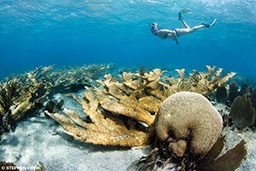
Jardines de la Reina has a few things going for it. It’s situated 60 miles south of Cuba’s central coast near the village of Jucaro, which is itself a six-hour bus ride from Havana. (I’m no political science whiz, but it occurs to me that if for the past 50 years you didn’t want your citizens to drive their boats 90 miles to Key West you probably shouldn’t allow them to have enough fuel of go fishing somewhere that involves a 120-mile round trip.) Perhaps even more important, Jardines de la Reina was a favorite spearfishing and scuba diving spot for Fidel Castro, and he had no desire to see it get fished out. Fishing was discouraged even before the area was officially a marine preserve.
According to the group EcoWatch, which interviewed Castro on the subject in 2014, he deemed marine conservation to be important for Cuba. “Castro told us that he had fished and dived the extraordinary reef (Jardines de la Reina) over its entire 60-mile length.… He also told us about his personal evolution as an environmentalist. He began as an avid marlin fisherman and spearfisherman who slaughtered many marine species on the reef, assuming the oceans were infinite and could never be depleted, … then he met with marine conservationist Jacques Cousteau. That meeting helped transform Castro into a committed environmentalist. He has committed to preserve 25 percent of Cuba’s waters from extractive fishing as marine preserves, while the U.S. lags, preserving less than 2 percent of our coastal waters.”
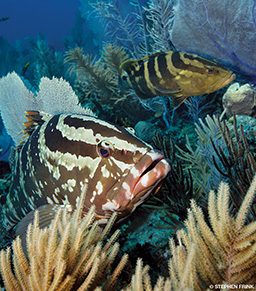
In 1996 the Gardens of the Queen officially became a marine preserve — one of the largest in the Caribbean. This is significant in many ways; it goes far beyond the dive tourism we enjoyed for a week this past July. As the New York Times observed in an article on July 14, 2015, the U.S. and Cuba are two countries whose ecosystems are closely interconnected, the environmental successes or missteps of one affecting the health and productivity of the other.”
“When you have two areas that are 90 miles away, it’s not only possible but it’s probable that a considerable number of eggs and larvae are moving between Cuban and American reefs,” Jake Kritzer, an ocean and fisheries expert at the Environmental Defense Fund, told the New York Times.
Jorge Angulo-Valdés, a senior scientist at Havana University’s Center for Marine Research, also observed, “Our two countries are connected by the water, and fish and other organisms move freely there. They don’t need a visa to come down or go up.”

A study by marine biologist Fabián Pina Amargós, director of Cuba’s Center for Coastal Ecosystem Research, found that fish populations have increased 30 percent since the preserve was established, and shark populations are 10 times greater within the protected zone than in the waters outside.
Now that I’ve visited the Gardens of the Queen I can revise my assessment of Cuba diving. With an impressive density of marine life and pristine coral reefs, “overwhelmed” is more like it.
The Travel
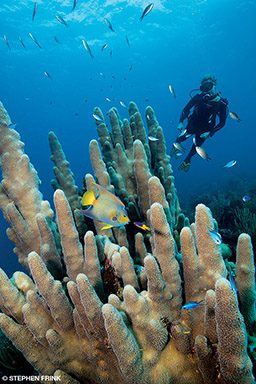
We traveled to Cuba on a People to People International program. Even though diplomatic relations are thawing and commercial flights from the U.S. to Cuba resumed Aug. 31, 2016, travel to Cuba is not without regulation. Simple tourism is still prohibited by statute, but there are 12 categories of authorized travel, including journalistic activity, public performances or sports competitions, professional research and meetings, humanitarian projects and educational activities.
As part of our program we visited Havana, which was worth the trip if for no other reason than to see the people, the architecture and the cars from 1950s Detroit that still rule the roads. Having grown up in an era when as a child I could name every car on the road, whether DeSoto, Studebaker, Ford, Plymouth or Chevrolet, Havana was astonishing. To the endless fascination of American tourists of a certain age, the city was filled with dream cars from the days before I could drive. The Baby Boomers on our bus kept shouting out “’57 Bel Air,” “’58 T-Bird,” “’52 Buick,” “’56 Fairlane!” My 23-year-old daughter didn’t share our enthusiasm for old cars, but even she knew this was a situation unique in the world — a function of five decades of embargo that forced Cubans to be resourceful and respectful of their cars. There was much to appreciate about Havana; I don’t think you could visit and not be impressed by the culture, history and fine dining.
The Jardines de la Reina are a group of 250 coral and mangrove islands 60 miles offshore, so factoring in our travel time from Havana and the boat ride to the dive sites, the first day would be fully dedicated to travel. Once we joined our liveaboard we quickly shoved off to sea, enjoying lunch and what was to become our collective passion for the week: mojitos — concoctions of white rum, lime juice, sugar, soda water and crushed mint. We were happy to indulge in a drink or three, as we wouldn’t be diving that day.
Gardens of the Queen
Checkout dives are often done at some crappy reef where nothing can be harmed by an errant fin stroke or poor buoyancy control. With that in mind I was pleasantly surprised to see massive and pristine pillar corals punctuating the seafloor at Boca de Anclitas. A friendly queen angel darted between the spires of this giant coral colony, making for a great photo op with my daughter as model. A pair of Nassau grouper kept nudging ever nearer my housing’s dome port. Whether they were seeing themselves in the reflection or had targeted me as a potential fish-feeder, I wasn’t quite sure. Soon after our first giant stride it became clear that these fish did not associate divers with spears. No Nassau or black grouper could survive to this size in these waters without protection.
The Sharks of Jardines de la Reina

We enjoyed many dives with Caribbean reef sharks. I expected them — part of my research for this trip was watching a 60 Minutes episode about the Gardens of the Queen with Anderson Cooper. It aired five years ago but was still very informative and well done. The significant populations of sharks were a big talking point in the program, with healthy shark populations being directly correlated to healthy reefs.
We did not have sharks swarming around us like in that video. We might see four or five on a dive, and occasionally they’d come near enough for a good photo. The crew noticed how excited we all were whenever a shark photo was in the evening’s image reviews, and eventually the cruise director asked our opinion about putting a bait box in the water. He assured us it would be a very low-key thing — more of a “scented” dive than a “baited” dive. The divemasters wouldn’t be donning chainmail and actually feeding the sharks. Would we mind? We assured them we’d be quite happy with that.
The bait box was transformational in facilitating close encounters with the Caribbean reef sharks. They circled the box constantly, and divers who had no interest in shark photography proceeded with a relaxed dive on a gorgeous coral reef. Divers who were interested in shark proximity could have many close encounters on these scented dives. We were consistently rewarded with beautiful environmental portraits of shark and coral reef. All in all, the action with these sharks on the reef was very mellow.
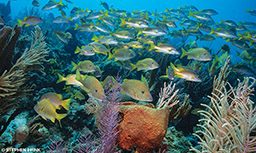
We didn’t bother with the bait box on every dive. It was so productive early in the trip that we tended to concentrate on other subjects later in the week. But sharks were there on almost every dive. Most were Caribbean reef sharks (Carcharhinus perezii), but a couple of dives purposely featured silky sharks (Carcharhinus falciformis).
While C. perezii are reef sharks, C. falciformis are dwellers of the open sea. According to sharksider.com: “[Silky sharks] have an extremely strong sense of hearing. This acts as a great advantage for locating their prey, mostly consisting of bony fish (especially tuna), octopuses, and squids.… They dive together into large groups of fish and attack them with lighting-fast speed and wide-open mouths.”
To find the silkies we motored westward and dived along some deep coral canyons in 60-80 feet. The bait box was deployed about 10 feet beneath the boat. We did our dive, and when we ascended back to about 30 feet we saw the silkies had come to play. Probably 12 or 14 large sharks were darting about, but always in a fairly subdued and deliberate manner. They did amp up when small bits of bait were tossed into the water, as they raced to claim their share. But it was never overly frenzied, and I don’t recall any bumps or uncomfortably close encounters. Anyone preferring a more passive encounter could stay a few yards farther from the bait box. The combination of very clear water and abundant sharks made this the most productive spot for silkies I’ve ever dived.
The Queen’s Crocodiles
Since I’ve been home and posted some of my crocodile shots on social media, I’ve had several inquiries about when we’d do our next “croc trip,” as if that was the reason we went to Cuba. I found this kind of comical, because a typical Cuba dive expedition does not involve a lot of time with these crocodiles. But the high probability of an encounter, especially for someone who has never seen a crocodile up close and in clear water, means for that day, that hour, it is a croc trip.
There is an area back in the mangroves where dive operators over many years have developed a relationship with a few resident American crocodiles (Crocodylus acutus). Less aggressive than the infamous Nile and Australian crocodiles, American crocodiles are normally shy, but not in the Gardens of the Queen. Once we get near the site the guides call out the name of a familiar crocodile, “Niño, Niño!” If it is the right time of day and the mood strikes, he’ll often swim out to the boat. Almost all the crocodile photos you’ve seen lately in photo competitions and dive magazines are of Niño. He works hard for the little bit of raw chicken they give him as a reward, but the popularity of these photos isn’t just because the animal is so charismatic, it’s also a product of the remarkable background. This is an absolutely magic environment of clear water (at high tide anyway), with abundant seagrass below and mangrove forest above. If an over/under photo with a crocodile is on your wish list, there may be no better place on the planet to get one.
The Coral Reefs
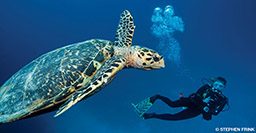
The liveaboard’s two dive skiffs would motor out to nearby reefs, but never the same one to prevent overcrowding. At Five Seas we were rewarded with an excellent tarpon encounter. While relatively rare on dive sites elsewhere in the Caribbean, we would find tarpon in residence at many of these sites. These weren’t huge aggregations, but groups of four to eight were common, usually under ledges. They were quite tolerant of approach, and the colorful sponge and coral backgrounds made a stark contrast to their silvery shimmer.
The diving was uniformly excellent, and many sites shared common features. We would typically tie up to a mooring buoy and drop in onto a shallow plateau at 15-20 feet. Then there would be a slope, quite often to a mini-wall that dropped to 60 or 80 feet. Often there were ledges and undercuts that were brightly decorated with sponges. This was a favorite hangout for nurse sharks as well as tarpon. On certain sites, such as Octopus Cave, giant schools of grunt, porkfish and schoolmaster snapper comingled.
We’d often see large black grouper and quite a few Nassau grouper as well. This may have been just good luck, but I think they have been fed over the years — classically conditioned to associate the sound of a boat with food. They are resident to that reef and forever optimistic. Even though our crew did not feed them, they were very attentive.
Goliath Grouper
I should note that we didn’t see any goliath grouper, which are apparently considered a consistent highlight of Gardens of the Queen diving. I wasn’t all that surprised, however. This was about this same time of year that we see them leaving the reefs in the Florida Keys and also the time of year they are observed in aggregations off the deep reefs and wrecks of Jupiter, Fla. With a spawning season of July-September, goliath grouper have at least 10 spawning aggregation sites in Cuba. Jardines de la Reina and Canarreos archipelagos were cited as possible recruitment and nursery sites. The biggest conservation concern, however, is fishers targeting the goliath grouper during their spawn, which is when they are most vulnerable and most important to the perpetuation of their species.
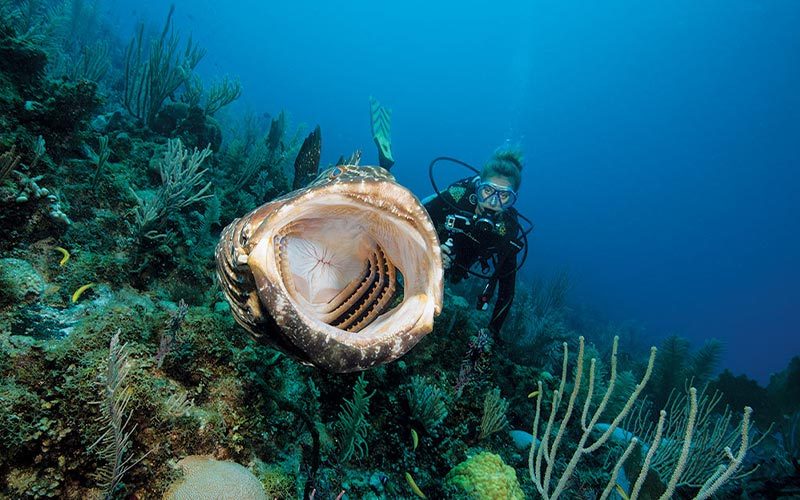
There were many other highlights during this truly inspirational week of diving. I have a hard time calling out specific reefs because they were all so very good. I could say “on this one a friendly turtle swam with me for 200 yards, a Caribbean reef shark passed right by my shoulder, and a school of porkfish posed in perfect symmetry.” But, frankly, that could have been on almost any dive. We became accustomed to extraordinary Caribbean marine life, yet what astonished me the most was the density of coral cover.
If you want to go back in time, my recommendation is to go to Cuba. I started diving Key Largo in 1978, but on most of the reefs we dived in the Gardens of the Queen in 2016, the coverage by boulder corals, sea fans and gorgonia was even greater than we had in Key Largo back then.
We never really traveled very far to the north or south along the Gardens of the Queen reef, which is 75 miles long. I assume this was because the operator knows the reefs well. Even though liveaboards with greater range now ply the waters, for many years a floating hotel with small dive skiffs motoring out to explore only the range they could reach before they had to head back for lunch or dinner was the only way divers could experience the Gardens of the Queen. The operators discovered the best ones, cultivated them by befriending sharks and grouper and kept coming back. This is fine, because the coral is still excellent and shows no obvious signs of diver impact. It was all new to us. But there must be countless dive spots yet to be discovered. That’s reason enough to book a return trip to “the Caribbean that time forgot.” As great as it is now, I’m sure it will continually evolve as a dive destination.
How to Dive It
There aren’t a lot of variables in Cuban dive travel to Jardines de la Reina. You can do it only with a couple of nonprofit organizations recognized and licensed by the Cuban government. The trip will be carefully choreographed to optimize your pleasure but also to minimize American tourists wandering amok throughout the country. All that may change with the advent of commercial air arrivals and cruise ships in Havana Harbor, but for now it is blessedly constrained. You’ll be met at the airport and be with guides either topside or underwater each step of the way. I found the attention helpful rather than obtrusive, and the Cuban people were so friendly and engaged it was fun to just be around them.
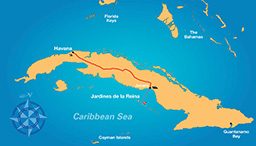
Entry Requirements: Visitors must have a current passport, a visa (which tour operators often can obtain for their travelers), adequate funds to support themselves, a return airline ticket, proof of travel health insurance and a verification letter from their organizing agency to travel to Cuba. You might be asked for the letter upon exit, though we were not.
Currency and Credit Cards: You won’t be able to use your credit cards in Cuba. Most expenses will have been prepaid, but you’ll need cash for incidentals and gratuities. Bring only crisp bills without undue wear or damage. I tried to buy a Cohiba cigar with a torn $50 bill and was turned down.
Water Temperature and Sea Conditions: Jardines de la Reina is protected from most prevailing winds. Unless there is a tropical storm or hurricane, the seas tend to be calm. The seasonal variability is in the water clarity. In the winter, when the water drops to 78°F, the visibility ratchets up to more than 100 feet. When we were there in July, the water was 84°F-86°F and the viz was 50-90 feet.
Currents: Some sites have currents, including passes between the islands where channels accelerate the tidal flow. There are also sites without any current. We had no current at all during our week of diving. These dive professionals are very skilled in delivering safe diving opportunities, and most have been guides here for many years. Though these dive sites are new to Americans, Canadians and Europeans have been nibbling our forbidden fruit for decades.
Explore More
© Alert Diver — Q4 Fall 2016